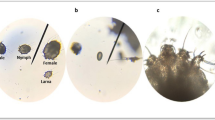Abstract
The morphological conversion of Coccidioides immitis in vivo was observed using the agar-implantation method.
Short hyphae implanted into the peritoneal cavity of mice swelled gradually and many septa appeared in them after 48 hours. As the implantation period advanced, these arthroconidia swelled and then broke up into spherical cells at the 72nd hour.
On the other hand, arthroconidia implanted into the peritoneal cavity of mice also swelled and became immature spherules within 72 hours. During the 96th hour a few of the spherules reached a stage of maturity. They were filled with numerous endospores.
The agar-implantation method is therefore a useful for the demonstration of spherules of C. immitis.
Similar content being viewed by others
References
Baker, E. E., E. M. Mrak & C. E. Smith, 1943. The morphology, taxonomy, and distribution of Coccidioides immitis Rixford and Gilchrist 1896. Farlowia 1: 199–244.
Converse, J. L., 1955. Growth of spherules of Coccidioides immitis in a chemically defined liquid medium. Proc. Soc. Exp. Biol. Med. 90: 709–711.
Drutz, D. J. & A. Catanzaro, 1978. Coccidioidomycosis. Part I. Am. Rev. Respir. Dis. 117: 559–585.
Drutz, J. D. & M. Huppert, 1983. Coccidioidomycosis: Factors affecting the host-parasite interaction. J. Infect. Dis. 147: 372–390.
Emmons, C. W., C. H. Binford, J. P. Utz & K. J. Kwon-Chung, 1977. Coccidioidomycosis. In Medical Mycology (3rd edition). Lea & Febiger, Philadelphia: 230–253.
Miyaji, M., K. Nishimura & F. Kuroda, 1973. Studies on the parasitic forms of Rhinocladiella pedrosoi (1). Jpn. J. Med. Mycol. 14: 20–25.
Miyaji, M. & K. Nishimura, 1977. Investigation of dimorphism of Blastomyces dermatitidis by agar-implantation method. Mycopathologia 60: 73–78.
Miyaji, M. & K. Nishimura, 1982. Murine coccidioidomycosis — Reproductive cycle of spherule and tissue responses. Jpn. Med. Mycol. 23: 287–296.
Nishimura, K. & M. Miyaji. Dimorphism of Microascus cirrosus. Mycopathologia (in press).
Rippon, J. W., 1982. Coccidioidomycosis. In Medical Mycology. The pathogenic fungi and the pathogenic actinomycetes (2nd edition), p. 389–427, W. B. Saunders Company, Philadelphia, London, Toronto: 389–427.
Sakakibara, S. & C. Mizuno, 1937. A case report of granuloma Coccidioides (disseminated Coccidioidomycosis) (in Japanese). Grenz-Gebiet 11: 1765–1777.
Tarbet, J. E., E. T. Wright & V. D. Newcomer, 1952. Experimental coccidioidal granuloma. Developmental stages of sporangia in mice. Am. J. Pathol. 28: 901–917.
Author information
Authors and Affiliations
Rights and permissions
About this article
Cite this article
Miyaji, M., Nishimura, K. Conversion of Coccidioides immitis from a mycelial form to spherules using the ‘agar-implantation method’. Mycopathologia 90, 121–123 (1985). https://doi.org/10.1007/BF00436863
Issue Date:
DOI: https://doi.org/10.1007/BF00436863




